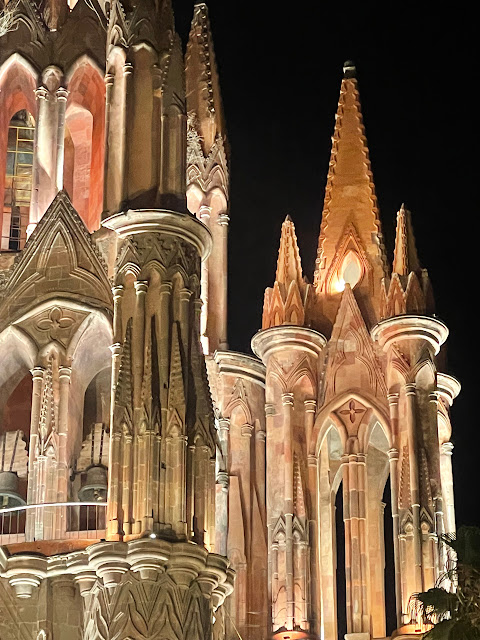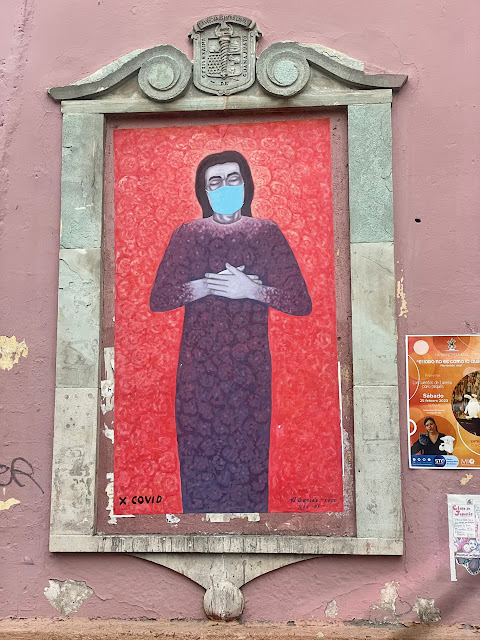About this time of year, I get the itch to go away for a week or so. I long for sunshine and blue skies; for exotic food and drink; rich colors and textures; for music and a language that I am moved by — but barely understand; and finally for unplanned days and romantic nights that come from exploring a faraway place.
We found just such an offering on our most recent trip to the mountains of central Mexico, exploring the colonial towns of Querétaro City, San Miguel de Allende, and Guanajuato. We fell in love with each of these places: their colorful palettes, majestic churches, shady plazas, and lively historic centers. Each day we awoke to a cloudless sky beaconing us to wander the cobblestone lanes, discovering the treasures of each town.
While they are located within an hour or so of each other, they each offered a personality as different as each of my sisters’ is to me.
Querétaro City
Our first stop was the UNESCO World Heritage town of Querétaro, to which we arrived 12 hours later than scheduled (thanks to mechanical delays by American Airlines), which meant that we arrived just in time to lay our heads down at our lovely hotel.
 |
| Breakfast at our hotel: La Casa Del Atrio |
We spent the next morning walking the streets, stopping for a coffee, a delightful lunch at Meson de Chucho el Roto, followed by a tour of the Calendar Museum. That evening to celebrate Valentine’s Day, we took an Uber to the outskirts of town to the very hip beer garden: Cerveceria Hércules.
 |
| Al fresco lunch |
______________________
San Miguel de Allende
Voted the 2021 World's Best City (by Travel & Leisure magazine), San Miguel does not disappoint, as it is indeed very beautiful. With cobblestone streets that rise from the city center, it boasts the most rooftop restaurants of any town its size. We stayed near the top of one of the main streets, about a six-block hike up hill, in a beautiful hacienda with only six guestrooms.
 |
| Sitting Room of our hotel: Hacienda Las Amantes |
San Miguel is a magnet for expats looking to retire surrounded by beauty. Nearly 20 percent of its population has immigrated there, mostly from the U.S. and Canada. I only worry that they will get too tottery to manage the steep cobblestone streets and uneven sidewalks. In the meantime, they seem to be living a wonderful life.
In addition to the traditional souvenir shops, the town offers a beautiful art and design center, just outside of the historic district. In the evenings, everyone seems to congregate in the main plaza as mariachi bands ply for paid-song requests. The cathedral glows with the setting sun and everyone seems happy. I know we were.
On our last day in San Miguel, we took an Uber out to the middle of no-where to a prehispanic settlement called Cañada de la Virgen. Our driver dropped us off and promised to return in 2.5 hours. (We couldn’t call him as there was no internet.) On our own, we figured out that tours were offered every hour, and one must have a guide provided by the site. Turns out the next couple of tours were already filled with 80+ high schoolers; fortunately they were able to work us onto one of the shuttle busses that took us to within a 1/2 mile or so of the ruins. From there, we walked. The only other non-highschoolers were a couple from Loma Linda, CA, Joann and Pablo, who graciously took pity on our lack of Spanish language skills and translated for us. We had a delightful day exploring the site.
 |
| Cañada de la Virgen |
Guanajuato
Our last stop was Guanajuato, a former mining town where the the houses — in every imaginable Crayola color — tumble down the hills that surround it. Despite the town’s beauty, it’s not a perfectly restored town. It retains a certain grittiness, presenting itself as a city where people actually live, work, study, and play.
 |
| Our hotel: San Bernabé Tres |
The tourists seem to come from all over Mexico. We ran into very few Americans, except for Joann and Pablo, whom we had met at the Cañada de la Virgen ruins (see above). We spotted them across the street and they joined us for a before-dinner drink under a beautiful laurel tree.
Memorable highlights include: Riding the town’s funicular straight up the mountain to the base of the Monumento Al Pipila for a panoramic view of the town.
 |
| Al Pipila statue |
The other highlight was stumbling upon an evening music parade through the narrow streets and alleyways, performed by eight talented (and very funny) singers and musicians from the local University. They joked, sang and led the crowd. We followed, stopping at predetermined spots for a drink or bouquet. Highly entertaining.
________________
And before we knew it, it was time to head home. Our heads hit our pillows at midnight; the next morning, a red-winged blackbird greeted us — a sure sign that spring is coming to Farm Dover.
_________________
A final note:
It was nearly three years ago that we last traveled to Mexico, arriving back home just as the world shut down for Covid. We are so grateful that we can again freely travel...

















